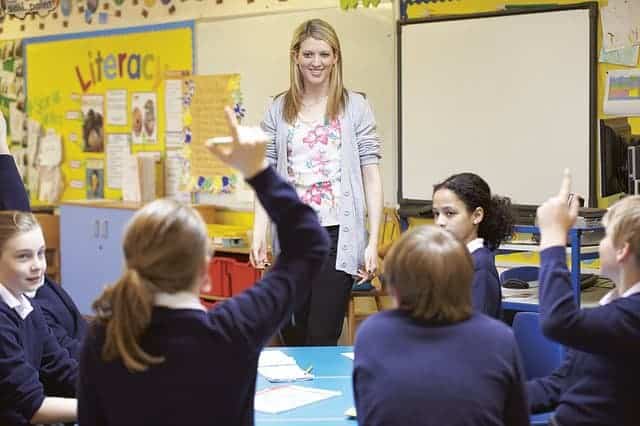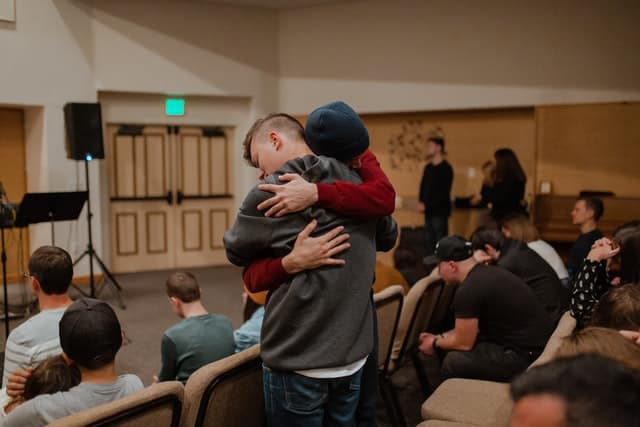Anyone who spends time with children understands that play is more than a frivolous pastime. It’s the work of childhood. Work through which the next generation learns skills like effective communication, conflict resolution, problem-solving, and cooperation.
In this article, we discuss learning through play, cooperative play, and provide examples of cooperative games for kids that can be used in the classroom.
Cooperative Games for Kids
The Six Stages of Play
American sociologist and researcher, Mildred Parten, dedicated much of her career to studying the art of play. As a result of her research, Parten identified six stages of play through which most children progress. She was careful to note that each child is unique and can progress at different rates. Even so, the stages do tend to follow one another eventually.
The six stages of play, as outlined in a study by Michigan State University include the following:
1. Unoccupied play (0-3 months)
Unoccupied play is that which we observe in babies or young children. In this stage, children explore materials around them in an unorganized fashion. The focus of this stage is learning how the world works.
2. Solitary play (0-2 years)
During this stage children are content to entertain themselves. The main skills they acquire as they are preparing to play with other children are new motor and cognitive skills.
3. Onlooker play (2 years)
Children involved in onlooker play are actively watching others. As they observe, children learn about the social rules of play and relationships–rules they will eventually employ when they feel ready to jump in for themselves.
4. Parallel play (2-3 years)
This play occurs when children play side-by-side but aren’t interacting with one another’s games. This stage does not include social engagement but it does teach children further social skills and gives them a framework for inviting others into their play in the future.
5. Associative play (3-4 years)
During this stage, children shift their focus from activities or objects of play to other players in the game. The focus of this stage is practicing what they’ve learned through observing others and building social skills with other children or adults.
6. Cooperative play (4+ years)
This is play categorized by cooperative efforts between players. Children become interested in both the game and the players. To this end, they begin to communicate desired outcomes and collaborate toward a common goal while understanding that each person has a distinct role to play.
The way our children learn to play is an excellent example of the constructivist theory of education. This theory is based on the idea that learners build on their existing knowledge to learn new information. As such, cooperative play is not only a capstone achievement for our students, it is also a catalyst from which they can grow into healthy adults and effective members of society.
The skills children derive from cooperative play that, in turn, provide the crucial foundation upon which they build future success include working together to achieve a common goal, developing the ability to problem-solve, sharing and exploring ideas, speaking and listening, and improving social, mental, emotional, and physical agility.
Additionally, Kathy Hirsh-Pasek, a professor of psychology at Temple University and co-author of Becoming Brilliant: What Science Tells Us About Raising Successful Children with Roberta Golinkoff, breaks down the skills kids need to succeed with the “six C’s,” which include— collaboration, communication, content, critical thinking, creative innovation, and confidence (NPR). Cooperative play helps children to learn these C’s.
Examples of Cooperative Games for Kids

Chief among cooperative games for kids are those that teach team-building skills. To that end, we’ve compiled a list of team-building games that have been proven to build both confidence and skill. Those listed are mainly cooperative games for the classroom but can also be adapted for online learning.
Here are our top five cooperative games for kids from various resources:
Classification (WeAreTeachers)
Set-Up: For this activity, prepare a tray with 20 unrelated items. For example, a spool of thread, an eraser, a juice box, etc. Once you’ve selected your items, create a document with 20 images of your selected items to put up on the screen. Divide your class into even groups.
Instructions: Set a timer and have each group divide the 20 items into four categories that make sense to them. For example, they may put an earring, a glove, a headset, a sock, and a smile into the category “things you wear.” Have groups work quietly so that their ideas are kept secret. When the time is up, give each group time to present their categories and the rationale behind each category.
Connect This (Teachhub)
Set-Up: Provide each team with four different images and ask students to come up with a short story that connects all the objects together. For example, the images can be a person, an object, a location, etc.
Instructions: Give students about 15-20 minutes to discuss and come up with a story, then present their story to the class.
Guided Reciprocal Peer Questioning (The University of Tennessee Chattanooga)
The goal of this activity is to generate discussion among student groups about a specific topic or content area.
Set-Up: Faculty conducts a brief (10-15 minutes) lecture on a topic or content area. Faculty may assign a reading or written assignment as well. The instructor gives the students a set of generic question stems. Question stems help students to come up with or write questions about a text or topic.
Instructions: Students work individually to write their own questions based on the material being covered. They do not have to be able to answer the questions they pose. This activity is designed to encourage students to think about ideas relevant to the content area. The students should use as many question stems as possible.
Grouped into learning teams, each student offers a question for discussion, using the different stems.
Sample question stems:
What is the main idea of…?
What if…?
How does…affect…?
What is a new example of…?
Explain why…?
Explain how…?
How does this relate to what I’ve learned before?
What conclusions can I draw about…?
What is the difference between… and…?
How are…and…similar?
How would I use…to…?
What are the strengths and weaknesses of…?
What is the best…and why?
Three-step Interview (University of Tennessee Chattanooga)
Three-step interviews can be used as an ice breaker for team members to get to know one another or can be used to get to know concepts in-depth, by assigning roles to students.
Set-Up: The teacher assigns roles or students can “play” themselves. Teachers may also give interview questions or information that should be “found.”
Student A interviews Student B for the specified number of minutes, listening attentively and asking probing questions.
At the teacher’s signal, students reverse roles and B interviews A for the same number of minutes. At a second signal, each pair turns to another pair, forming a group of four. Each member of the group introduces his or her partner, highlighting the most interesting points.
Share Experiences and Feelings (University of Central Arkansas)

Set-Up: The teacher selects a short video (10-15 minutes) on the topic of their choice. The topic should have some relevance to the lives of the students watching.
Instructions: When the video is over, organize students into groups and ask them to discuss the following questions:
- What is my experience with [the topic]?
- What are the major feelings associated with the experience?
- Discuss how this affects our interactions with others.
At the teacher’s signal, the class comes together as a whole and one representative from each group shares the overall feelings expressed in the group. Once every group has been represented, the teacher can ask one debriefing question, “What are the implications of these experiences to you?” Or, for younger students, “How does understanding your classmates’ feelings about these experiences help you understand them better?”
Cooperative Games in the Classroom
As you plan to lead cooperative games for your students, be sure to choose games that are appropriate for their stage of development. Equipping our kids to engage with one another productively helps build healthy students, classrooms, and communities.
Soul Shoppe provides social emotional learning programs for elementary schools, parents, corporations, and more. We also provide a peacemaker program with both training and certification. View our online courses or contact us for more information here.
You May Also Like:
Conflict Resolution Activities for Kids

